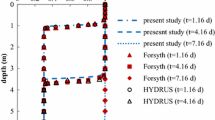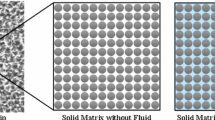Abstract
The aim of the present work is to present an overview of some numerical procedures for the simulation of free surface flows within a porous structure. A particular algorithm developed by the authors for solving this type of problems is presented. A modified form of the classical Navier–Stokes equations is proposed, with the principal aim of simulating in a unified way the seepage flow inside rockfill-like porous material and the free surface flow in the clear fluid region. The problem is solved using a semi-explicit stabilized fractional step algorithm where velocity is calculated using a 4th order Runge–Kutta scheme. The numerical formulation is developed in an Eulerian framework using a level set technique to track the evolution of the free surface. An edge-based data structure is employed to allow an easy OpenMP parallelization of the resulting finite element code. The numerical model is validated against laboratory experiments on small scale rockfill dams and is compared with other existing methods for solving similar problems.

















Similar content being viewed by others
Notes
The hydraulic gradient is the measure of the variation of the hydraulic head for unit length [20].
Eq. (3) is by definition the volumetric porosity \(n^{v}\) whereas in Fig. 1 a cross section of the control volume is considered and a sectional porosity \(n^{a} := A_{E}/A \) should be defined as the ratio between the area of pores and the total cross section area. Consequently, a lineal porosity can also be defined as the ratio between the length of pores over the total length (\(n^{l}:= l_{E}/l\)). Fortunately Bears in [3] demonstrated that in a porous medium this distinction is unnecessary being
$$\begin{aligned} n^{v} = n^{a} = n^{l}. \end{aligned}$$The Reynolds number is the dimensionless coefficient that, being the ratio between inertia and viscous forces, quantifies the relative importance of each one for a given flow [20]. It is defined as \(\frac{\rho u \, l}{\mu } \) where \(\rho \) is the fluid density and \(l\) is a characteristic length (in pipes it coincide with the diameter).
Eq. (1) and all the alternative non linear formulations that are presented in the next sections are commonly called resistance laws because they measure the resistance made by the porous matrix to the fluid flow.
References
Andrade JA Jr, Costa UMS, Almeida MP, Makse HA, Stanley HE (1998) Inertial effects on fluid flow through disordered porous media. Phys Rev Lett 82(26):5249–5252
Bear J (1972) Dynamics of fluids in porous media, chapter. American Elsevier, New York
Bear J (1988) Dynamics of fluids in pouros media. Elsevier, USA
Chen Y, Hu R, Lu W, Li D, Zhou C (2011) Modeling coupled processes of non-steady seepage flow and non-linear deformation for a concrete faced rockfill dam. Comput Struct 89:1333–1351
Chilton TH, Colburn AP (1931) Pressure drop in packed tubes. Ind Eng Chem 23:913–919
Codina R (2000) A nodal-based implementation of a stabilized finite element method for incompressible flow problems. Int J Numer Methods Fluids 33:737–766
Codina R (2000) On stabilized finite element methods for linear system of convection–diffusion-reaction equations. Comput Methods Appl Mach Eng 188:61–82
Codina R (2000) Pressure stability in fractional step finite element methods for incompressible flows. J Comput Phys 170:112–140
Codina R (2000) Stabilization of incompressibility and convection through orthogonal sub-scales in finite element method. Comput Methods Appl Mach Eng 190:1579–1599
Codina R (2002) Stabilized finite element approximation of transient incompressible flows using orthogonal subscales. Comput Methods Appl Mech Eng 191:4295–4321
Codina R, Soto O (2004) Approximation of the incompressible navier–stokes equations using orthogonal subscale stabilization and pressure segregation on anisotropic finite element meshes. Comput Methods Appl Mach Eng 193:1403–1419
Dadvand P, Rossi R, Oñate E (2010) An object-oriented environment for developing finite element codes for multi-disciplinary applications. Arch Comput Methods Eng 17:253–297
de Lemos MJS (2006) Turbulence in porous media. Elsevier, UK
del Jesus M, Lara JL, Losada IJ (2012) Three-dimensional interaction of waves and porous coastal structures. Part i: nomerical model formulation. Coast Eng 64:57–72
Da Deppo L, Datei C, Salandin P (2002) Sistemazione dei corsi d’acqua. Libreria Internazionale Cortina, Padova
Donea J, Huerta A (2003) Finite elements methods for flow problems. Wiley, New York
Du Plessis JP, Masliyah JH (1988) Mathematical modeling of flow through consolidated isotropic porous media. Transport porous media 3:145–161
Ergun S (1952) Fluid flow through packed columns. Chem Eng Prog 48:89–94
Fancher GH, Lewis JA (1933) Flow of simple fluids through porous materials. Ind Eng Chem 25:1139–1147
Ghetti A (1984) Idraulica. Ed. Cortina, Milano
Hansen D (1992) The behaviour of flowthrough Rockfill dams. PhD Thesis: Univerity of Ottawa, Canada
Hsu T-J, Sakakiyama T, Liu PL-F (2002) A numerical model for wave motions and turbulence flows in front of a composite breakwater. Coast Eng 46(1):25–50
Khoei AR, Mohammadnejad T (2011) Numerical modeling of multiphase fluid flow in deforming porous media: a comparison between two- and three-phase models for seismic analysis of earth and rockfill dams. Comput Geotech 38(2):142–166
Kratos, multiphysics opensource fem code. http://www.cimne.com/kratos
Larese A (2012) A coupled Eulerian-PFEM model for the simulation of overtopping in rockfill dams. Phd thesis: Universitat Politècnica de Catalunya (UPC BarcelonaTech), Barcelona, Spain
Larese A, Rossi R, Oñate E (2011) Coupling eulerian and lagrangian models to simulate seepage and evolution of failure in prototype rockfill dams. In: Proceeding of the XI ICOLD benchmark workshop on numerical analysis of dams, SpanCOLD, Madrid, Spain, ISBN: 978-84-695-1816-8
Larese A, Rossi R, Oñate E (2011) Theme b: simulation of the behavior of prototypes of rockfill dams during overtopping scenarios: seepage evolution and beginning of failure. In: Proceeding of the XI ICOLD benchmark workshop on numerical analysis of Dams, SpanCOLD Madrid, Spain, ISBN: 978-84-695-1816-8
Larese A, Rossi R, Oñate E, Idelsohn SR (2012) A coupled pfem–eulerian approach for the solution of porous fsi problems. Comput Mech 50(6):805–819. doi:10.1007/s00466-012-0768-9
Larese A, Rossi R, Oñate E, Toledo MA, Moran R, Campos H (2013) Numerical and experimental study of overtopping and failure of rockfill dams. Int J Geomech (ASCE). doi:10.1061/(ASCE)GM.1943-5622.0000345
Li B (1995) Flowthrough and overtopped rockfill dams. Phd thesis: Universty of Ottawa ISBN: 0-612-15734-2
Li B, Garga VK (1998) Theoretical solution for seepage flow in overtopped rockfill. J Hydraul Eng Comput 124:213–217
Li B, Garga VK, Davies MH (1998) Relationships for non-darcy flow in rockfill. J Hydraul Eng 124(2):206–212
Li T, Troch P, De Rouck J (2004) Wave overtopping over a sea dike. J Comput Phys 198(2):686–726
Lin P (1998) Numerical modeling of breaking waves. Ph.D. thesis, Cornell University
Löhner R (2001) Applied computational fluid dynamics techniques. Wiley, UK
Lubin P, Vincent S, Caltagirone J-P, Abadie S (2003) Fully three-dimensional direct numerical simulation of a plunging breaker. Comptes Rendus Mecanique 331(7):495–501
Martins JP, Milton-Taylor D, Leung HK (1990) The effects of non-darcy flow in propped hydraulic fractures. In: Proceedings of the SPE Annual Technical Conference
McCorquodale JA, Hannoura AA, Nasser MS (1978) Hydraulic conductivity of rockfill. J Hydraul Res 16(2):123–137
Morán R (2013) Mejora de la seguridad de las presas de escollera frente a percolación accidental mediante protecciones tipo rapié. PhD Thesis: Universidad Politécnica de Madrid, Madrid, Spain
Morán R, Toledo MA (2011) Reserarch into protection of rockfill dams from overtopping using rockfill downstream toes. Can J Civil Eng 38(12):1314–1326
Nield DA, Bejan A (1992) Convection in porous media. Springer, New York
Niessner J, Hassanizadeh SM (2008) A model for two-phase flow in porous media including fluid-fluid interfacial area. Water Resourc Res 44(8). doi:10.1029/2007WR006721
Nithiarasu P, Seetharamu KN, Sundararajan T (1997) Natural convective heat transfer in a fluid saturated variable porosity medium. Int J Heat Mass Transf 40:3955–3967
Nithiarasu P, Sujatha KS, Ravindran K, Sundararajan T, Seetharamu KN (2000) Non-darcy natural convection in a hydrodynamically and thermally anisotropic porous medium. Comput Methods Appl Mech Eng 188:413–430
Nithiarasu P, Sundararajan T, Seetharamu KN (1997) Double-diffusive natural convection in a fluid saturated porous cavity with a freely convecting wall. Int Commun Heat Mass Transf 24:1121–1130
Osher S, Fedkiw RP (2003) Level set methods and dynamic implicit surfaces. Springer, New York
Rossi R, Larese A, Dadvand P, Oñate E (2013) An efficient edge-based level set finite element method for free surface flow problems. Int J Numer Meth Fluids 71(6):687–716. doi:10.1002/fld.3680
Ryzhakov P, Rossi R, Oñate E (2012) An algorithm for the simulation of thermally coupled low speed flow problems. Int J Numer Methods Fluids 70(1):1–19
Scheidegger AE (1974) The physics of flow through porous media. University of Toronto Press, Toronto
Schrefler BA, Scotta R (2001) A fully coupled dynamic model for two-phase fluid flow in deformable porous media. Comput Methods Appl Mech Eng 190(24–25):3223–3246
Sheng D, Sloan SW, Gens A, Smith DW (2003) Finite element formulation and algorithms for unsaturated soils. Part i: Theory. Int J Numer Anal Methods Geomech 27:745–765
Soto O, Lohner R, Cebral J, Camelli F (2004) A stabilized edge-based implicit incompressible flow formulation. Comput Methods Appl Mech Eng 193:2139–2154
Stephenson D (1969) Rockfill Hydraul Eng. Elsevier Scientific, Amsterdam
Szymkiewicz A (2013) Modelling water flow in unsaturated porous media, chapter mathematical models of flow in porous media. Springer, Berlin
Taylor DW (1948) Fundamentals of soil mechanics. Wiley, New York
Toledo MA (1997) Presas De Escollera Sometidas a Sobrevertido. Estudio del Movimientos dal Agua a Través de la Escollera e de la Estabilidad Frente al Deslizamiento en Masa. PhD thesis: Universidad Politécnica de Madrid
Toledo MA (1998) Safety of rockfill dams subject to overtopping. In: Proceding of the international symposium on new trend an guidelines on dam safety, Taylor & Francis Inc. isbn 9054109742, 9789054109747
Uzuoka R, Unno T, Sento N, Kazama M (2014) Effect of pore air pressure on cyclic behavior of unsaturated sandy soil. Proceedings of the 6th International Conference on Unsaturated Soils, UNSAT 2014, Sydney, vol 1, pp 783–789
Wang Z, Zou Q, Reeve D (2009) Simulation of spilling breaking waves using a two phase flow cfd model. Comput Fluids 38(10):1995–2005
Wilkins JK (1956) Flow of water through rockfill and its aplication to the desing of dams. In: Proceedings of 2nd Australia—New Zealand conference on soil mechanics and foundation engineering
Zeng Z, Grigg R (2006) A criterion for non-darcy flow in porous media. Transp Porous Media 63:57–69
Zienkiewicz OC, Chan AHC, Pastor M, Schrefler BA, Shiomi T (1999) Computational geomechanics with special reference to earthquake engineering. Wiley, New York
Zienkiewicz OC, Taylor RL (2004) The finite element method, vol 3, fluid dynamics. Butterworth-Heinemann, Oxford
Acknowledgments
The research was supported by the FP7-Capacities ULITES project GA-314891 and ERC Advance Grant SAFECON project AdG-267521. The authors wants to acknowledge Prof. Miguel Angel Toledo, Dr. Rafa Moran and Mr. Hibber Campos of the Technical University of Madrid (UPM), Mr. Angel Lara and Mrs. Pilar Viña of CEDEX for the experimental results provided for this work.
Author information
Authors and Affiliations
Corresponding author
Rights and permissions
About this article
Cite this article
Larese, A., Rossi, R. & Oñate, E. Finite Element Modeling of Free Surface Flow in Variable Porosity Media. Arch Computat Methods Eng 22, 637–653 (2015). https://doi.org/10.1007/s11831-014-9140-x
Received:
Accepted:
Published:
Issue Date:
DOI: https://doi.org/10.1007/s11831-014-9140-x




